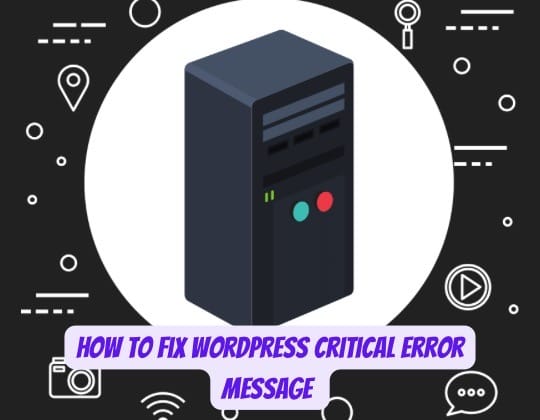
WordPress is a popular content management system (CMS) that powers millions of websites worldwide. While it is known for its user-friendly interface and extensive customization options, WordPress users may occasionally encounter errors that can be frustrating and challenging to resolve. One such error is the WordPress “Critical Error” message, which can be caused by various factors, including PHP issues, plugin or theme conflicts, and server-side problems. In this comprehensive guide, we will explore the causes, solutions, and prevention strategies for the WordPress “Critical Error” message, adhering to Google‘s helpful content standards on expertise, accuracy, transparency, comprehension, and reader value.
The WordPress “Critical Error” message is a common issue that can be alarming for website owners. This error can be caused by a variety of factors, primarily related to PHP issues, plugin or theme conflicts, or server-side problems. Understanding the causes, solutions, and prevention strategies is essential for effectively managing and resolving this error. In this article, we will provide a detailed and comprehensive guide to help you fix the WordPress “Critical Error” message and prevent it from occurring in the future.
Understanding the Causes of WordPress Critical Errors
Before diving into solutions, it’s crucial to understand what might be triggering the critical error on your WordPress site.
PHP Issues
The most common cause of the critical error is related to PHP, either due to exceeding the PHP memory limit or errors in PHP code within plugins or themes. To resolve PHP issues, you can increase the PHP memory limit, update the PHP version, or debug the PHP code.
Plugin and Theme Conflicts
Conflicts between plugins or between a theme and a plugin can lead to critical errors. This occurs when different plugins or themes have conflicting code. To identify and resolve plugin or theme conflicts, you can deactivate all plugins and switch to a default WordPress theme, then reactivate them one by one to pinpoint the problematic component.
Server-Side Problems
Issues such as database connection errors, internal server errors, and high server load can also trigger the critical error message. To resolve server-side problems, you can check and repair the database, optimize the server performance, or contact your hosting provider for assistance.
Corrupted Files
Corrupted WordPress core files, themes, or plugin files can result in critical errors. To fix corrupted files, you can reinstall WordPress core files, replace the corrupted theme or plugin files, or use a file integrity checker.
Insufficient Memory
If the website exceeds the available memory, essential processes may fail, causing the error message to appear. To resolve insufficient memory issues, you can increase the PHP memory limit, optimize the database, or reduce the number of plugins and themes installed on your website.
Outdated PHP Version
Using an outdated PHP version can lead to compatibility issues with WordPress, contributing to critical errors. To resolve this issue, you can update the PHP version to a supported version compatible with your WordPress version.
Solutions to Resolve WordPress Critical Errors
Once you’ve identified the potential cause, you can take steps to resolve the critical error.
Increase PHP Memory Limit
Increasing the PHP memory limit can be done by editing the wp-config.php file. This can provide more breathing room for your website’s processes.
Disable Plugins and Themes
By deactivating all plugins and switching to a default theme, you can determine if the error is due to a specific plugin or theme. This process of elimination is a tried-and-true method for pinpointing the issue. To disable plugins and themes, follow these steps:
- Access your website’s admin dashboard using an FTP client or the file manager provided by your hosting provider.
- Navigate to the
wp-contentfolder. - Rename the
pluginsfolder toplugins_deactivated. This will deactivate all plugins installed on your website. - Rename the
themesfolder tothemes_deactivated. This will deactivate the current theme and activate the default WordPress theme. - Refresh your website to see if the critical error has been resolved.
- If the error is resolved, rename the
plugins_deactivatedfolder back toplugins. - Reactivate the plugins one by one by renaming their respective folders. Refresh your website after each reactivation to identify the problematic plugin.
- Once you have identified the problematic plugin, delete it or contact the plugin developer for assistance.
- Repeat the process for the themes by renaming the
themes_deactivatedfolder back tothemesand reactivating the themes one by one.
Check and Repair the Database
Using tools like phpMyAdmin to check and repair the WordPress database can resolve issues stemming from database corruption. To check and repair the database, follow these steps:
- Access your website’s hosting control panel and open phpMyAdmin.
- Select the WordPress database from the list of databases.
- Click on the “Check All” button to select all tables in the database.
- Select the “Repair Table” option from the dropdown menu.
- Click the “Go” button to start the repair process.
- Refresh your website to see if the critical error has been resolved.
Update PHP Version
Ensuring that your hosting environment is running a PHP version that’s compatible with your WordPress installation is crucial for preventing critical errors.
Use Debug Mode
Enabling WordPress debug mode provides specific error messages that can help you identify the exact cause of the critical error. To enable debug mode, follow these steps:
- Access your website’s root directory using an FTP client or the file manager provided by your hosting provider.
- Locate the
wp-config.phpfile and open it in a text editor. - Add the following line of code before the
/* That's all, stop editing! Happy publishing. */line:
define('WP_DEBUG', true);
- Save the changes and close the file.
- Refresh your website to see if any specific error messages appear.
- Use the error messages to identify and resolve the root cause of the critical error.
Reinstall WordPress Core Files
If corrupted files are to blame, replacing the WordPress core files with a fresh copy can often fix the problem. To reinstall WordPress core files, follow these steps:
- Download the latest version of WordPress from the official website.
- Extract the downloaded file and delete the
wp-contentfolder and thewp-config-sample.phpfile. - Access your website’s root directory using an FTP client.
- Upload the remaining files and folders to your website’s root directory, overwriting the existing files.
- Refresh your website to see if the critical error has been resolved.
Prevention Strategies to Avoid Future WordPress Critical Errors
Preventing critical errors is just as important as knowing how to fix them.
Regular Updates
Keep WordPress core, plugins, and themes updated to prevent compatibility issues and security vulnerabilities. Regular updates ensure that your website is running the latest and most secure versions of the software.
Use Quality Plugins and Themes
Only install plugins and themes from reputable sources to reduce the risk of conflicts and errors. Quality plugins and themes are less likely to cause issues and are more likely to be compatible with your website.
Implement Regular Backups
Maintain regular backups of your WordPress site so you can easily restore it in case of critical errors. Regular backups ensure that you can quickly recover your website if something goes wrong.
Monitor PHP Memory Usage
Monitor your site’s PHP memory usage and adjust the memory limit as needed to prevent exhaustion. Monitoring PHP memory usage helps you identify potential issues before they cause critical errors.
Secure Your Website
Implement security measures to protect your site from malware and hacking attempts that can lead to critical errors. Securing your website helps prevent issues that can cause critical errors and ensures that your website is safe and reliable.
Conclusion
The WordPress “Critical Error” message is a fixable issue. By understanding its causes, applying the right solutions, and adopting preventative measures, you can ensure your WordPress site remains healthy and operational. Remember to approach each error with a systematic troubleshooting process, and don’t hesitate to seek professional help if the problem persists. With a proactive attitude and the right knowledge, you can maintain a WordPress site that is both secure and reliable.
